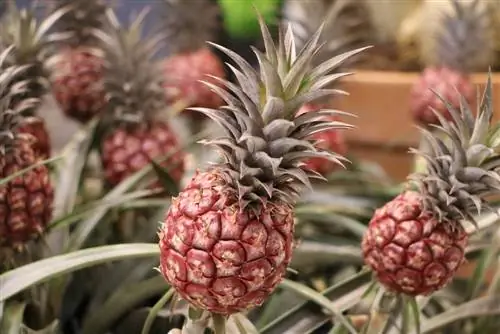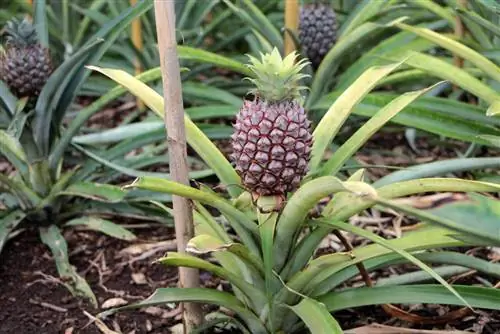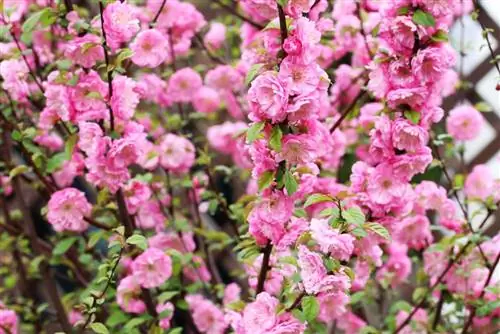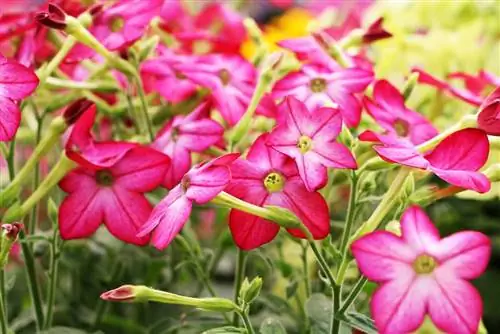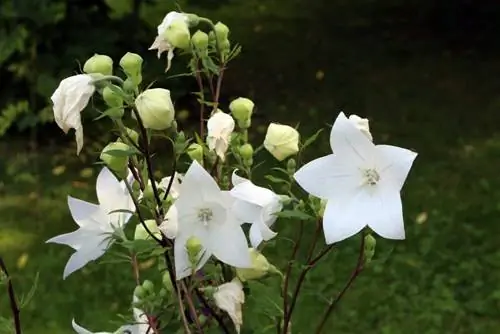- Author admin [email protected].
- Public 2023-12-17 03:39.
- Last modified 2025-01-24 12:45.
Pineapples are not only very popular in these latitudes for consumption. The tropical fruit is also available as a houseplant in a smaller form as an ornamental pineapple. The Ananas comosus is generally easy to care for and can also be easily propagated. The plant even bears fruit, although these are quite small. In order for the pineapple to form the small offshoots, the so-called Kindel, it needs the right care conditions.
Care
The ornamental pineapple behaves like its big sister, whose fruits are available in local stores. Therefore, the same must be observed when caring for it. Since it is a tropical plant, it requires high temperatures and humidity. Only after a few years does it show a pink flower, from which the pink-colored fruit later develops. If it ripens, it is edible, although this rarely happens in these latitudes. After fruiting once, the mother plant usually dies. But before that it forms many small offshoots, the so-called Kindel, which can be used for propagation. And the fruit itself can also be used to grow a new plant. But it is easier to grow a new plant over the kindle than over the fruit itself.
Tip:
If there are small children or free-roaming pets in the household, make sure that they do not come into contact with the pointed and possibly prickly leaves of the Ananas comosus, as these can cause injuries if touched improperly.
Location
The Ananas comosus is grown as a houseplant in a pot because it is not hardy, but can be moved outdoors in the warm summer months. However, the following conditions must be observed for the ideal location:
- bright and warm
- Temperatures not below 25° Celsius
- only morning and evening sun
- no direct midday sun
- Window sill on an east or west window
- sheltered terrace or balcony
- A heated winter garden is ideal
- Make it a little darker and cooler in winter
If you move the plant outdoors in summer, you have to pay attention to the best conditions. Especially when the temperatures are not particularly high in the summer months, the plant is better left in sheltered living spaces where it can be given the desired conditions.
Tip:
If the ornamental pineapple does not receive enough light or heat in the chosen location, you can also use a plant lamp and a heat lamp.
Plants

The ornamental pineapple is available in pots from specialist retailers. However, this is not suitable for further cultivation as a houseplant. Because the substrate should be replaced, the containers are usually just cheap, light plastic pots. Therefore, the plant should be given a new pot and transplanted immediately after purchase. The container you choose should also be a little larger than the existing pot. When planting, proceed as follows:
- Pineapple does not tolerate waterlogging
- therefore create drainage
- Potter shards, expanded clay or stones over drain hole
- here plant fleece
- fill in part of the earth
- Carefully remove the plant from the pot
- Removing soil from root balls
- put in the planter
- Fill up the remaining soil and water it
Substrate & Soil
The pineapple, which is native to the sandy soils of the tropics, does not require many nutrients. Therefore, nutrient-poor cactus soil is best suited for the plant. Sand can also be mixed in to ensure permeability against waterlogging. However, the soil should always be kept moist.
Fertilize
The ornamental pineapple does not need a lot of fertilizer to grow and produce its flowers and later fruits. You can fertilize every one to two weeks during the summer months and about every four weeks in the winter. For this purpose, commercially available liquid fertilizer for blooming flowers is used, which is administered with the irrigation water. The fertilizer should never be applied directly to dry soil, this will damage the roots and they could burn.
Tip:
The ornamental pineapple only shows flowers after four to five years, so a little patience is required, although age-appropriate plants are often available in stores.
Pouring
Ananas comosus needs more water in summer than in winter. However, it should never be watered too much. When watering, you should pay attention to the following:
- Use low-lime, soft water
- collected rainwater is ideal here
- water more in summer
- always keep moist, do not let it dry out
- less water supply in winter
- check the moisture of the soil with your finger
- also requires high humidity
- spray with water daily
- Place humidifier in close proximity
Cutting
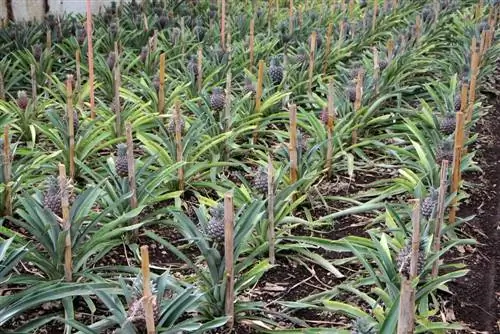
The ornamental pineapple generally does not require pruning. Because it has something special. Once it has flowered and produced its fruit, it usually dies. Since older plants between four and six years old are usually available in stores, they have already reached flowering maturity and mature size. However, leaves that are yellow or dried out should be removed regularly. Because these not only look unsightly but also take away the strength of the plant, which it can put into the he althy leaves and flowers.
Propagation via the fruit
The fruits of the Ananas comosus usually do not ripen in these latitudes and can therefore be removed from the bush for propagation. A new plant can then be grown over the stem. But this process is not that easy, as rot can quickly occur and roots will then not form. When propagating via the fruit, you should proceed as follows:
- medium ripeness of the fruit is optimal
- yellowish color and firm flesh
- Separating the fruit from the mother plant
- cut the leaf from the fruit
- if the fruit is ripe, it can be eaten
- remove all fruit residue from the stem
- Put on heater to dry for two to three days
- protects against rot
- Put the stem in a glass with water
- the first roots appear, letting them become 3 to 5 mm long
If sufficiently long roots have formed, the new plant can be planted and moved to the chosen location. The ornamental pineapple plants that you have grown yourself through propagation live longer because they now need about five years until they bloom.
Tip:
Before the ornamental pineapple is to be propagated, the leaves of the plant should be checked. If these are not fresh green, the plant may be sick. In such a case, propagation is not recommended, as the disease usually already exists in offshoots.
Propagate through Kindel
Kindel is the name given to the offshoots that an Ananas comosus produces. These clearly visible side shoots directly at the base are formed by the mother plant before it dies after flowering and fruiting once. The advantage of these kindlings is that they are already small pineapple plants that have all the properties of an adult plant. Propagation by Kindel then works as follows:
- cut off all the children around it
- about ten to fifteen centimeters
- fill small pot with potting soil
- A peat-sand mixture is also suitable
- Put the child in it
- Keep soil moist, not too wet
- put over transparent foil
- alternatively cut off the neck of the PET bottle
- place over pot
- Partly shaded location is ideal
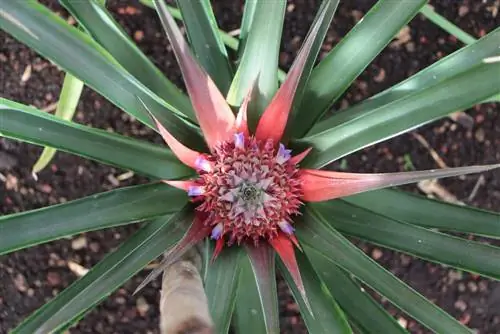
The plant must be ventilated regularly so that too much moisture cannot form under the foil or plastic and the child becomes rotten. After about eight to ten weeks, new roots will form on the young plant; the film should now be completely removed. Now the ornamental pineapple is transplanted into a larger pot and cared for and treated like an adult plant.
Tip:
It should not be omitted to remove the children for propagation. Because shortly afterwards the mother plant dies. If the children were not planted in their own pots to form roots, they will also die, which can and should be avoided.
Repotting
Since the Ananas comosus only grows very slowly, you can provide it with a sufficiently large container right from the start. This means that it does not need to be repotted during its relatively short life. Since a nutrient-poor substrate is usually used, replacing the soil is not necessary.
Wintering
The ornamental pineapple is not hardy and, as it comes from the tropics, requires warm temperatures all year round. This means that they should not fall below 18° Celsius even in winter. Higher temperatures are usually better, so that the plant can remain in your location in a window or in the heated winter garden. Furthermore, the following should be taken into account when wintering:
- water less
- especially when it's not so warm anymore
- Continue spraying the plant from above
- Reduce fertilizer application
- only every four weeks
- not quite set
Tip:
If the plant is kept in the apartment all year round, then in winter special attention must be paid to high humidity in the immediate vicinity of the plant due to the dry heating air. In addition to a humidifier, several bowls of water can also be placed around the pineapple plant.
Care errors and illnesses
If the ornamental pineapple is affected by diseases, then these are primarily care errors that could be avoided. Basically, pineapple plants are not very susceptible to diseases. However, they can suffer so much from cool temperatures or waterlogging that these care errors can severely affect the plant. Over-fertilization can also occur. If the otherwise lush green leaves of the ornamental pineapple turn yellow or brown, you should act as follows:
- Check substrate for wetness
- if it is too wet, remove the plant
- Let the roots dry
- place in fresh substrate and water less
- Immediately remove from the container even if there is over-fertilization
- remove all soil from the roots
- place in nutrient-poor substrate
- do not fertilize in the near future
- Check ambient temperature
- Adjust if too cool
All measures should be taken immediately if the pineapple appears sickly. However, it is not always clear whether these promise success. Nevertheless, you should act as quickly as possible, because it is always worth trying to save the decorative ornamental pineapple.
Pests
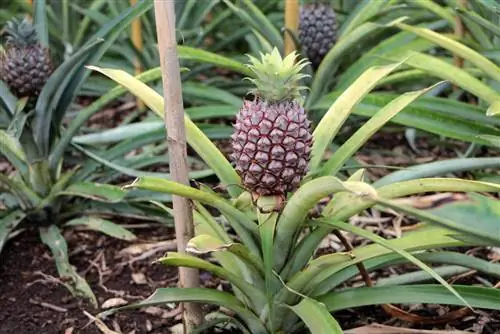
Especially in the winter months, the otherwise quite resistant pineapple is often attacked by scale insects. But this is also usually due to incorrect care and this should be checked for the following points:
- maybe the location is too dark
- was fertilized too much in winter
- is the plant generally weakened for other reasons
In addition to changing the poor conditions mentioned above, a shower helps against scale insects, during which all pests should be removed. If the humidity is increased, the annoying insects usually don't come back. In the event of a stubborn infestation, insecticides must be used, which should actually be avoided in closed living spaces due to their toxicity to humans.

